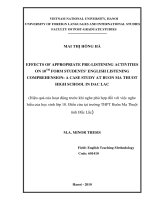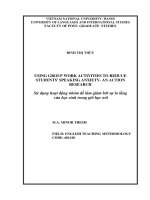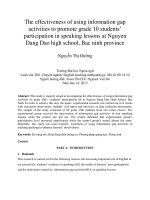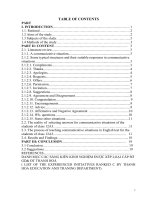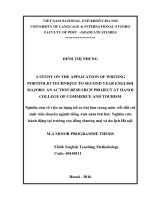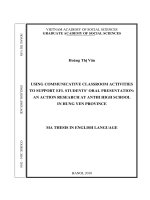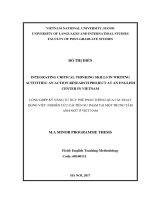Using communicative classroom activities to support EFL students’ oral presentation: An action research project at Nguyen Trai-Ba Dinh High school in Hanoi
Bạn đang xem bản rút gọn của tài liệu. Xem và tải ngay bản đầy đủ của tài liệu tại đây (842.65 KB, 107 trang )
VIETNAM ACADEMY OF SOCIAL SCIENCES
GRADUATE ACADEMY OF SOCIAL SCIENCES
BÙI THỊ THỦY
Bùi Thị Thủy
ENGLISH LANGUAGE
USING COMMUNICATIVE CLASSROOM ACTIVITIES
TO SUPPORT EFL STUDENTS’ ORAL PRESENTATION:
AN ACTION RESEARCH PROJECT
AT NGUYEN TRAI-BA DINH HIGH SCHOOL IN HA NOI
MA THESIS IN ENGLISH LANGUAGE
COURSE: 2017 – 2019
HA NOI, 2019
VIETNAM ACADEMY OF SOCIAL SCIENCES
GRADUATE ACADEMY OF SOCIAL SCIENCES
Bùi Thị Thủy
USING COMMUNICATIVE CLASSROOM ACTIVITIES
TO SUPPORT EFL STUDENTS’ ORAL PRESENTATION:
AN ACTION RESEARCH PROJECT
AT NGUYEN TRAI-BA DINH HIGH SCHOOL IN HANOI
Field: English Language
Code: 8220201
Supervisor: Nguyễn Thị Việt Nga, Ph.D.
HA NOI, 2019
DECLARATION BY AUTHOR
I, Bùi thị Thủy, certify that the thesis entitled “Using communicative
classroom activities to support EFL students’ oral presentation: An action
research project at Nguyen Trai-Ba Dinh High School in Hanoi” is the result
of my own research for the Degree of Master of Arts in English language. I
confirm that this thesis has not been submitted for any other degrees.
The research reported in this thesis was approved by Graduate
Academy of Social Sciences.
Author’s Signature
Bùi Thị Thủy
Approved by
SUPERVISOR
Nguyễn Thị Việt Nga, Ph.D.
Date: …………………………..
i
ACKNOWLEGDEMENTS
Although only one name appears as the author of this work, writing a
thesis is indeed a collaborative effort. I would like to express my sincere
thanks to the many people who made it possible.
First of all, I would like to express my heartfelt gratitude to my M.A
thesis’s supervisor, Dr. Nguyễn Thị Việt Nga for her kind consultation,
invaluable encouragement as well as thorough correction in the process of
completion. Without her helpful guidance, this study would not have been
achieved.
Next, I would like to convey my sincere appreciation and thanks to Mr.
Đặng Nguyên Giang and the staff of the Department of Foreign Languages,
Graduate Academy of Social Sciences for granting me the honor of writing
this thesis as well as their assistance and most valuable comments.
Specially, millions of my special thanks go to the teachers and students
of Nguyen Trai- Ba Dinh High School who participated in this study for their
kind and patient co-operation and encouragement. They helped provide me
with valuable data for the study so that I could have a better view of activities
in presentation task in English speaking classes at Nguyen Trai- Ba Dinh
High School in Ha Noi.
Finally, I am deeply indebted to my family for their sympathy and
support during all the time I was studying for M.A degree at Graduate
Academy of Social Sciences. Without their unconditional love and sincere
contribution, I could not have overcome my difficulties and concentrated on
my studies..
ii
TABLE OF CONTENTS
DECLARATION BY AUTHOR..................................................................... i
ACKNOWLEGDEMENTS............................................................................ ii
ABSTRACT .................................................................................................... vi
LIST OF TABLES ........................................................................................ vii
LIST OF FIGURES & CHARTS ............................................................... viii
LIST OF ABBREVIATIONS ....................................................................... ix
CHAPTER 1: INTRODUCTION .................................................................. 1
1.1.
Rationale ............................................................................................... 1
1.2.
Aims and Objectives of the Study ........................................................ 2
1.3.
Research Questions............................................................................... 3
1.4.
Scope of the Study ................................................................................ 3
1.5.
Significance of the Study...................................................................... 3
1.6.
Research Methods................................................................................. 3
1.7.
Structure of the Study ........................................................................... 3
CHAPTER 2: LITERATURE REVIEW...................................................... 5
2.1.
Communicative Competence................................................................ 5
2.2.
Communicative Language Teaching .................................................... 7
2.3.
Communicative Activities .................................................................... 8
2.3.1. Definition of Communicative Activities ................................................................... 8
2.3.2. Characteristics of Communicative Activities .......................................................... 9
2.4.
Oral Presentation ................................................................................ 10
2.4.1. General Understanding of Oral Presentation. ..................................................... 10
2.4.2. Skills/ Sub-skills Involved in Oral Presentation.................................................... 12
2.4.3. The Problems Faced by Students When Doing Oral Presentation ................... 15
2.4.4.2. Organization of the Presentation......................................................................... 19
iii
2.4.4.3. Presentation Skills.................................................................................................. 20
2.4.4.4. Performing Self Reflections .................................................................................. 21
2.4.5. Evaluating and Assessing an Oral Presentation.................................................. 22
2.5.
Classroom Communicative Activities to Support Oral Presentation . 23
2.6.
Previous Studies ................................................................................. 27
2.7.
Summary ............................................................................................. 29
CHAPTER 3: METHODOLOGY............................................................... 30
3.1. Research Design ..................................................................................... 30
3.1.1. Definitions of Action Research................................................................................ 30
3.3.2. Action Research Procedures ................................................................................... 33
3.2. The Context of the Study ....................................................................... 35
3.3. Participants ............................................................................................. 36
3.3.1. The Researcher- Teacher......................................................................................... 36
3.3.2. The Teachers.............................................................................................................. 37
3.3.3. The Students ............................................................................................................... 37
3.4. Procedures of the Current Study ............................................................ 38
3.4.1. Diagnosing (week 1-2) ............................................................................................. 39
3.4.2. Planning (before the beginning of week 3)............................................................ 39
3.4.3. Acting and Observing (from Week 3 to Week 16) ................................................ 40
3.4.4. Reflecting (Week 17- 18) .......................................................................................... 41
3.5. Data Collection Instruments................................................................... 42
3.5.1. Diagnosing ................................................................................................................. 42
3.5.2. Acting and Observing ............................................................................................... 45
3.6. Data Collection....................................................................................... 49
3.7. Data Analysis ......................................................................................... 49
3.8. Summary ................................................................................................ 50
CHAPTER 4: FINDINGS AND DISCUSSIONS ....................................... 51
iv
4.1. Data Collection and Analysis from Survey Questionnaire .................... 51
4.1.1.
Survey Questionnaire for Teachers .................................................................. 51
4.1.2. Survey Questionnaire for Students ......................................................................... 56
4.2. The Data from the Speaking Test and English-Speaking Observation . 59
4.3. The Data from the Students’ Opinions through Communicative
Activities ....................................................................................................... 64
4.4. Discussions of the Findings ................................................................... 66
CHAPTER 5: CONCLUSION ..................................................................... 69
5.1.
Recapitulation ..................................................................................... 69
5.2.
Concluding Remarks .......................................................................... 70
5.3. Implications ............................................................................................ 71
5.3.1. Application of Communicative activities ............................................................... 71
5.3.2. Practical Tips for Teachers ..................................................................................... 72
5.4.1. Limitations.................................................................................................................. 74
5.4.2. Suggestions for Further Studies .............................................................................. 74
REFERENCES .............................................................................................. 75
APPENDIX 1 .................................................................................................... I
APPENDIX 2 .................................................................................................III
APPENDIX 3 .................................................................................................. V
APPENDIX 4 ................................................................................................. VI
APPENDIX 5 .............................................................................................. VIII
APPENDIX 6 ................................................................................................. IX
APPENDIX 7 ................................................................................................. XI
APPENDIX 8: .............................................................................................. XII
APPENDIX 9: ............................................................................................. XIV
APPENDIX 10: ............................................................................................ XX
v
ABSTRACT
This thesis has made attempts to examine: (1) the attitudes of the 10th
graders and the teachers at Nguyen Trai- Ba Dinh High School towards
communicative activities in speaking lessons, (2) if the use of communicative
activities could support the students in doing oral presentation tasks.
Specially, an action research project was carried out with the participation of
40 students in Grade 10A8 at Nguyen Trai- Ba Dinh High School in Hanoi.
The study lasted 18 weeks and involved some data instruments namely
questionnaire, pre-test, observation, post-test. The data collected in the initial
stage showed that the obstacles of doing oral presentation tasks mainly came
from the teaching methods and the differences of students’ English abilities,
which resulted in differences in their attitude to speaking lessons. An action
plan of applying communicative classroom activities was implemented. The
data collected in the action stage pointed out that the students’ oral
presentation was improved and the positive changes in their attitude toward
speaking classes were also witnessed after the intervention.
vi
LIST OF TABLES
Page
Table 1: A distinction between non- communicative activities
10
and communicative ones.
Table 2: Assessing Speaking Performance- Level B1 (CEFR)
23
Table 3: Procedures of the study
38
Table 4: Frame of Questionnaire for Teachers
44
Table 5: Frame of Questionnaire for Students
44
Table 6: A comparison of Mean Score on Pre-Test and Post-
60
Test by Three Raters
Table 7: A comparison of the Speaking Observation in Each
61
Lesson Plan
Table 8: The Mean Score of the Students’ Opinions toward
Communicative Activities
vii
65
LIST OF FIGURES & CHARTS
Page
Figure 1: Action Research Cycle
35
Chart 1: Category 1 of the Questionnaire for Teachers
52
Chart 2: Category 2 of the Questionnaire for Teachers
53
Chart 3: Category 3 of the Questionnaire for Teachers
54
Chart 4: Category 4 of the Questionnaire for Teachers
55
Chart 5: Category 1 of the Questionnaire for Students
56
Chart 6: Category 2 of the Questionnaire for Students
57
Chart 7: Category 3 of the Questionnaire for Students
58
Chart 8: Category 4 of the Questionnaire for Students
59
viii
LIST OF ABBREVIATIONS
AR:
Action Research
CEFR:
Common European Framework for Reference
CLT:
Communicative Language Teaching
EFL:
English as Foreign Language
ESL:
English as Second Language
L2:
Second Language
RQ:
Research Question
ix
CHAPTER 1: INTRODUCTION
1.1.
Rationale
Nowadays, in the era of the globalization and international exchange,
English is one of the most important means of communication and access to
information. In this context, the teaching and learning of English is more and
more necessary. English has become a compulsory subject at high school
throughout the country. Thanks to the innovation of new textbooks,
Vietnamese high schools now have a chance to get better access to
Communicative Language Teaching (CLT) methods, which bring students
interest in learning English. However, it is a fact that many high school
students do not find speaking practice interesting. They are not confident
enough to converse with English teachers or native speakers, especially in
doing oral presentation.
Furthermore, students’ oral presentation accounts for a major part of
many lessons at secondary schools as well as in universities because they are
one of the communicative goals. The potential benefits of developing student
oral presentations include greater class interaction and participation, increased
interest in learning, new perspectives, and improvement in communication
and presentation skills. Students can gain knowledge not only from the work
they and other students perform, but also by observing other presenters’
strengths and weaknesses to develop better communication and presentation
skills. Despite the positive aspects of using student presentations in the
classroom, some students may show resistance to do extra work, having fear
in public speaking, or displaying boredom while sitting through others’ oral
presentations. Therefore, such students may have generally negative beliefs
1
about giving classroom presentations.
As a teacher of English at Nguyen Trai- Ba Dinh High School, a
secondary school, for more than ten years, the researcher feels rather
concerned about her students’ English learning, especially their ability in
speaking English and making oral presentations. Although her students have
learnt English since they were in grade 3, under the new syllabus and new
methods based on the communicative approach, their foreign language
knowledge is thought not to be sufficient to meet the demands of using
English as an international language. Of course, they can hardly use English
to communicate and do presentation tasks. Wondering if applying
communicative classroom activities can help to motivate the students to solve
their incompetence as mentioned above, the researcher has decided to conduct
the study on “Using communicative classroom activities to support EFL
students’ oral presentation: An action research project at Nguyen Trai-Ba
Dinh High school in Hanoi” to find out the solutions, and, to help improve
the teaching and learning of English at her school
1.2.
Aims and Objectives of the Study
The aim of the study is to improve the EFL students’ oral presentation
at Nguyen Trai-Ba Dinh high school in Hanoi.
In order to achieve the aim, the study is expected to reach the following
objectives:
- Investigating the attitudes of the EFL students and the teachers towards
communicative classroom activities in speaking lessons;
- Evaluating the effectiveness of communicative classroom activities in
supporting EFL students’ oral presentation.
2
1.3.
Research Questions
The objectives of the study can be elaborated into the research
questions as follows:
1. To what extent do the communicative classroom activities support
the students in doing their oral presentation tasks?
2. What are the attitudes of the EFL students and the teachers towards
communicative classroom activities in speaking lesson?
1.4.
Scope of the Study
Due to time constraints, the study cannot cover all the techniques to
stimulate students’ speaking ability in a language class. Therefore, it mainly
focuses on some typical communicative classroom activities which may
produce a stimulus for the 10th grade Nguyen Trai - Ba Dinh High school
students’ oral presentation.
1.5.
Significance of the Study
Hopefully, the study will make a small contribution to the application
of communicative language teaching approaches in developing the students’
ability in doing oral presentation task at secondary school level in general and
at Nguyen Trai- Ba Dinh High School in Hanoi in particular.
1.6.
Research Methods
In order to achieve the aim, action research procedures are used in the
study. The data will be collected via survey questionnaires, class observations
and tests.
1.7.
Structure of the Study
3
The study consists of five chapters:
Chapter 1 – Introduction: The first chapter gives reasons for choosing
the thesis, scope and aims of the study as well as the research method and the
structure of the study.
Chapter 2 – Literature Review: This chapter focuses on an overview of
Communicative
Competence,
Communicative
Language
Teaching,
Communicative Activities, Oral Presentation as well as previous studies on
improving or developing students’ oral presentation.
Chapter 3 - Methodology: This chapter reports the context settings,
research hypothesis, participants, instruments and the procedure of conducting
Action Research for the study. The detailed results of the surveys and a
critical comprehensive analysis on the data collected are presented.
Chapter 4- Findings and Discussion: This part deals with the data
analysis from the Action Research results to make the foundation for the
activities recommended in Chapter 5.
Chapter 5 – Conclusion: This chapter summarizes the study and
suggests some typical activities as well as practical tips for teachers to
stimulate 10th -grade students’ oral presentation in an English speaking lesson.
Limitations of the study and suggestions for further study are also included in
this chapter.
4
CHAPTER 2: LITERATURE REVIEW
The study investigates the effectiveness of using communicative
classroom activities to support the Nguyen Trai- Ba Dinh High School
students’ oral presentation. This chapter reviews the theories and literature
relevant to the study area. It is divided into 6 parts, namely:
Communicative Competence,
Communicative Language Teaching,
Communicative activities,
Oral presentation,
Classroom communicative activities to support oral presentation, and
Previous studies.
2.1.
Communicative Competence
The term “communicative competence” is comprised of two words, the
combination of which means “competence to communicate”. This simple
lexico - semantic analysis uncovers the fact that the central word in the
syntagm
“communicative
competence”
is
the
word
“competence”.
“Competence” is one of the most controversial terms in the field of general
and applied linguistics. Its introduction to linguistic discourse has been
generally associated with Chomsky (1965) who in his very influential book
“Aspects of the Theory of Syntax” drew what has been today viewed as a
classic distinction between competence (the monolingual speaker-listener’s
knowledge of language) and performance (the actual use of language in real
situations).
Soon after Chomsky (1980) proposed and defined the concepts of
competence and performance, advocates for a communicative view in applied
5
linguistics (e.g. Savignon, 1972) expressed their strong disapproval at the idea
of using the concept of idealized, purely linguistic competence as a theoretical
ground of the methodology for learning, teaching and testing languages. They
found the alternative to Chomsky’s concept of competence in Hymes’s
communicative competence which they believed to be a broader and more
realistic
notion
of
competence.
Namely,
Hymes
(1972)
defined
communicative competence not only as an inherent grammatical competence
but also as the ability to use grammatical competence in a variety of
communicative situations, thus bringing the sociolinguistic perspective into
Chomsky’s linguistic view of competence.
Recent
theoretical
and
empirical
research
on
communicative
competence is largely based on the description of components of
communicative language competence in the Common European Framework
for Reference (CEFR, 2001), the model which is intended for assessment as
well as for learning and teaching of languages. In the CEF, communicative
competence is conceived only in terms of knowledge. It includes three basic
components – language competence, sociolinguistic competence and
pragmatic competence. Thus, strategic competence is not its componential
part. It is interesting, however, that each component of language knowledge is
explicitly defined as knowledge of its contents and ability to apply it. For
instance, language competence or linguistic competence refers to knowledge
of and ability to use language resources to form well-structured messages.
The subcomponents of language competence are lexical, grammatical,
semantic,
phonological,
orthographic
and
orthopedic
competences.
Sociolinguistic competence refers to possession of knowledge and skills for
appropriate language use in a social context. The following aspects of this
competence are highlighted: language elements that mark social relationships,
6
rules of appropriate behavior, and expressions of peoples’ wisdom,
differences in register and dialects and stress. The last component in this
model - pragmatic competence - involves two subcomponents: discourse
competence and functional competence. A part of both of these competences
is the so-called planning competence which refers to sequencing of messages
in accordance with interactional and transactional schemata. Strategic
competence is mentioned in the part the CEFR dedicated to a discussion of
communicative language use. This competence is conceived as strategy use in
the broadest sense. Thus, the stress is put not only on the use of
communication strategies which can help to overcome the lack in a particular
area of language knowledge but on the use of all types of communication
strategies. As to the authors of the CEFR, the use of strategies can be
compared with the application of meta-cognitive principles (planning,
achieving, controlling and correcting) on different forms of language activity:
reception, interaction, production and meditating.
2.2.
Communicative Language Teaching
Communicative Language Teaching (CLT) is an approach which
proposes that language learning should be done in a meaningful setting with
authentic language as the input. It is an umbrella term which consists of an
array of methods and techniques (Parrish, 2004). According to Lindsay and
Knight (2006, p.20), this approach is based on the view that language is learnt
in order to communicate effectively “in the world outside the classroom.” It
emphasizes on meaningful use of language for communication, rather than on
the form and structure; hence the term “real-life” communication in the
classroom (Brown, 2000). Savignon (2001, p.13) describes CLT as the “new”,
“innovative” way of teaching English as a second or foreign language as it
7
deals with “the interactive nature of communication.” CLT puts an
importance on fluency and ability to communicate in a variety of settings and
in a variety of ways. Nguyen (2010, p.209) points out that “CLT may
currently be considered and accepted as an inclusive approach to language
teaching, which encompasses various approaches and methods, motivations
for learning English, types of teachers and the needs of individual classrooms
and
students
themselves;
it
is
learner-centered
and
emphasizes
communication in real-life situations.” CLT emphasizes on contextualized,
meaning-based instructions and the use of authentic materials, as well as
maximum learner interaction (Parrish, 2004).
According to the principles of the CLT, the learners do not study only
the linguistic structures and the rules of grammar, but it stressed the
importance of using language for communication (Allwright, 1978; Cambell,
1972; Numan, 1991; Richards & Rodgers, 1995; Savignon, 1991). Besides,
Johnson (1981) suggested while studying, students must try to communicate
with their peers and try to make them understand what they have said.
Furthermore, teaching English for communication is to emphasize the
language competence for learners and they must try to communicate in real
situation (Murphy, 1991). As such, it could be conluded that in order to teach
language for communicative purposes, the teacher must put the emphasis on
the students’ communicative competence to use it in real communications.
2.3.
Communicative Activities
2.3.1. Definition of Communicative Activities
According to CEFR (2001, pp. 73-93), communicative activities with
one or more interlocutors are generally undertaken by a language user in
pursuance of his or her needs in a given situation. In the educational domain,
8
communicative tasks may be helpful to distinguish between the tasks which
learners are required to tackle as language users and those in which they
engage as part of the language learning process itself.
According to Hammer (1991), communicative activities are those that
give students the desire to communicate, involving them in a various use of
the language. Such activities are crucially important in a language classroom
since the students can do their best to use the language individually, arriving
at a degree of language autonomy. In other words, communicative activities
are those that can stimulate communicative competence in the learners.
Therefore, it is the teacher’s responsibility to find out appropriate activities to
encourage students to use the language. In order to design these activities
effectively, the teacher needs further understanding of them. Accordingly, the
following section will discuss the characteristics and types of communicative
activities.
2.3.2. Characteristics of Communicative Activities
According to Harmer (1991), Communicative Activities are those that
give students involved desire and a purpose to communicate. Such activities
are very beneficial for students because they can do their best to use the target
language and arrive at the degree of proficiency in the end.
Nolasco & Athur (1993) characterized communicative activities with
some following characteristics. Firstly, they involve using language for a
purpose. Secondly, they create a desire to communicate. This means there
must be some kind of “gap” which may be information, opinion, or reason
that students seek to bridge. Thirdly, they encourage students to be creative
and contribute their ideas. Fourthly, they focus on the message and students
concentrate on “what” they are saying rather than “how” they are saying it.
9
Fifthly, the students work independently off the teacher. Lastly, the students
determine what they want to write and say. The activity is not designed to
control what the students will.
In other words, communicative activities try to create authentic
communication. This is seen as contrary to monotonous drills which the
traditional method heavily relies on and which carry little communicative
functions. Harmer (2001), who holds the same view, makes a distinction
between non-communicative activities and communicative ones in the
following table:
Non-communicative Activities
Communicative Activities
A communicative desire
A communicative purpose
Content not form
Variety of language
No teacher intervention
No materials control
No communicative desire
No communicative purpose
Form not content
One language item only
Teacher intervention
Materials control
(Table 1: A distinction between non-communicative activities and
communicative ones)
2.4.
Oral Presentation
2.4.1. General Understanding of Oral Presentation.
The communicative approach to English teaching has been very
popular in many EFL college conversation classes. Having students give oral
presentations in front of the class is one of learner-centered activities that
have been widely included in teachers’ lesson plans to improve students’ oral
proficiency. According to CEFR (2001, pp. 58- 65), oral production is one of
the productive activities in which the language user produces an oral text
received by an audience of one or more listeners. Spoken production is a
10
‘long turn,’ which may involve a short description or anecdote, or may imply
a longer, more formal presentation. Productive spoken activities have an
important function in many academic and professional fields (oral
presentations and reports) and particular social value is attached to them.
Judgments are made of what has been submitted in the fluency and
articulateness in speaking, especially when addressing an audience. Ability in
this more formal production is not acquired naturally; it is a product of
literacy learnt through education and experience. It involves learning the
expectations and conventions of the genre concerned. Production strategies
are employed to improve the quality of both informal and formal production.
Planning is obviously more associated with formal genres, but Monitoring
and Compensating for gaps in vocabulary or terminology are also a quasiautomated process in natural speech.
The categories for spoken production are organized in terms of three
macro-functions (interpersonal, transactional, evaluative), with two more
specialized genres, namely: addressing audiences and public announcements
under the term sustained monologue created by transferring certain
descriptors from the scale for information exchange that implied monologue
rather than dialogue.
In any ESL classroom, especially speaking lesson, learners should
prepare and give oral presentation lasting for 5-10 minutes. The learners can
have notes with them. They can use simple visual aids such as an overhead
projector, blackboard, charts or diagrams if necessary. At the end of the
presentation, the speaker will have to deal with any questions from the
listeners. Making an oral presentation is an authentic purpose and
communicative activity both for academic and professional purpose. The
learners can make the presentations directly to the interviewer for a formal
11
test procedure. They can do a whole activity for a final summery without a
teacher or assessor. The learner, in consultation with his teacher, chooses the
appropriate topics.
Advantages of oral presentations are: bridging the gap between
language study and language use; using the four language skills in a naturally
integrated way; helping students to collect, inquire, organize and construct
information; enhancing team work and helping students become active and
autonomous learners.
The communicative approach to English teaching has been very
popular in many EFL conversation classes. Having students give oral
presentations in front of the class is one of learner-centered activities that
have been widely included in teachers’ lesson plans to improve students’ oral
proficiency.
2.4.2. Skills/ Sub-skills Involved in Oral Presentation
From what mentioned above, oral presentation, the kind of sustained
monologue is one of the illustrative scales provided in the oral production
activities.
Describing experience concerns narration and description. It has a
relatively direct link between communicative functions and the language used
to express them.
Giving information is a new scale concerned with explaining
information to a recipient in a long turn. Although the recipient may well
interrupt to ask for repetition and clarification, the information is clearly
unidirectional; it is not an exchange.
Putting a case (e.g. in debate) describes the ability to sustain an
argument.
12
Public announcements are a very specialized way of passing important
information to a group of people, perhaps in a private capacity (e.g. at a
wedding), perhaps whilst organizing an event or outing or in the manner of air
cabin staff.
Addressing audiences involves giving a presentation or making a
speech at a public event, in a meeting, seminar or class. Whilst the talk is
clearly prepared it is not usually read word for word. After a presentation, it is
customary to take questions spontaneously, answering in a short monologue.
Besides, most authors (e.g. Rungapadiachy, 1999; Hargie and Dickson,
2004; Hargie, 1997; Hayes, 2002; Ellis, 2003) tend to agree on a number of
core areas in which competency is essential for effective oral production.
These include the following:
Self-awareness: Self-awareness is considered to be a pre-requisite for
the type of “other-awareness” or empathy assumed to underlie effective
communication (Hayes, 2002).
Oral communication: Some of the processes involved in effective oral
presentations. The topic of oral communication is addressed in greater depth
by the corresponding learning area.
Reflecting: Another skill that is closely related to the psychological
sciences or counseling more specifically is the ability to reflect or present
reflections. Hargie and Dickson (2004, p.148) define reflections as
“statements in the interviewer’s own words that encapsulate and re-present
the essence of the interviewee’s own words”. Presenting reflections during
interactions can serve a similar information gathering function to that seen in
questioning.
Non-verbal communications: A number of communicative activities
also involve non-verbal behavior and an ability to detect and portray
13
messages through this medium is also seen as a central interpersonal skill
(Harrigan, Rosenthal and Scherer, 2005). Messages can be communicated
through the following non-verbal channels.
Facial expressions: Elman’s work in the area of facial expressions
(e.g. Ekman, 1992) provides solid evidence that information about an
individual’s emotional state can be transmitted via their facial expression. In
addition, facial expressions can be used to regulate interactions, for example
the synchronization of conversations (Hayes, 2002).
Gaze: Emotion information can also be communicated through gaze.
For example, long stares are often seen as signals of hostility or aggression.
Looking can also be used to initiate and regulate interpersonal interactions
and can be used to assess the reactions of others during oral presentations and
conversations (Hayes, 2002).
Gestures: Gestures can be used to replace words, in addition to words
to place emphasis on an element of a verbal message, or to regulate or signal
the beginning or end of an interaction (Ekman and Friesen, 1969, cited in
Hayes, 2002).
Posture: An individual’s posture can reveal how they feel and their
attitude towards others involved in the interaction (Argyle, 1994). Posture
also tends to vary as a function of how formal an interpersonal situation is
with more relaxed postures indicating less formal situations (Hayes, 2002).
Paralinguistic cues: Non-verbal vocal cues such as the pitch, tone and
speed of speech can also reveal information about emotional states and can be
used to regulate interactions. For example, people experiencing anxiety tend
to speak very quickly and in a high pitch (Scherer, 1981). Paralinguistic cues
can also regulate turn-taking in interactions and pitch changes also indicate
when questions have been asked.
14
